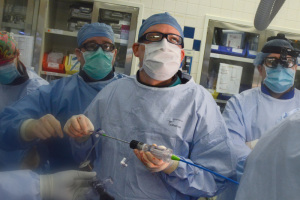by
John R. Fischer, Senior Reporter | September 06, 2017

BASILICA could save TAVR patients
with particular heart anatomies
A new technique may eliminate a fatal complication in heart operations for patients with aortic valve disease.
Physicians from Henry Ford Hospital, the University of Washington and the National Institutes of Health (NIH) have developed the Bioprosthetic Aortic Scallop Intentional Laceration to prevent Iatrogenic Coronary Artery obstruction (BASILICA) as an adjunct tool for assisting transcatheter aortic valve replacement (TAVR) operations.
“There is a small subset of patients who would benefit from TAVR but are at prohibitive risk of coronary obstruction,” Dr. Adam Greenbaum, a cardiologist and co-director of the Center for Structural Heart Disease at Henry Ford Hospital in Detroit who helped develop the technique, told HCB News. “In these cases, BASILICA allows us to proceed with and improves the safety of the TAVR.”



Ad Statistics
Times Displayed: 68418
Times Visited: 2225 Ampronix, a Top Master Distributor for Sony Medical, provides Sales, Service & Exchanges for Sony Surgical Displays, Printers, & More. Rely on Us for Expert Support Tailored to Your Needs. Email info@ampronix.com or Call 949-273-8000 for Premier Pricing.
TAVR involves inserting a catheter into the heart and using a balloon to open the new valve inside the aortic valve. Patients with particular heart anatomies though can be at risk of serious harm or even death if the native valve’s leaflets block the flow of blood to the coronary arteries while the new valve opens.
BASILICA prevents this complication with the cardiologist slicing the native aortic leaflet using a coronary guided wire in a practice called transcatheter electrical surgery. The wire is the size of a sewing needle and is inserted through a catheter. It is then electrified and used to slice the leaflet, preventing the flap from blocking the flow of blood through the heart when the new valve is deployed.
The first two uses of the technique were performed in July at the University of Washington in Seattle. Since then, two other procedures have been performed at Henry Ford Hospital and two at Emory University. The use of BASILICA adds half an hour to a standard TAVR procedure and requires an additional small sheath from the leg.
Greenbaum says, however, that the method enhances patient safety and could become a practical solution for when TAVR implants fail.
“Looking into the future, 10-15 years from now, if and when the hundreds of thousands of TAVR valves that are being been placed in younger patients start to fail (as we know surgically implanted valves do), this may become a huge problem,” he said. “Now we think we have the solution with BASILICA.”
The technique was invented by Dr. Jaffar Khan and Dr. Robert Lederman of NIH. It is a modification of their technique, Laceration of the Anterior Mitral valve leaflet to Prevent Outflow track ObstructioN (LAMPOON), which is used to create leaflet slices in the mitral valve and was first performed in May 2016.
Doctors performing BASILICA should be skilled in transcatheter electrical surgery.

